When it comes to delicious and versatile fruits, tree fruit like raspberry varieties are hard to beat. Raspberries, known for their vibrant colors and sweet-tart flavor, are a favorite among fruit enthusiasts. But did you know that raspberries belong to the Rubus genus, which includes other tree fruits like blackberries and related regional species?
Raspberry season is a joyous time of year when these delectable fruits reach their peak ripeness. The clusters of berries come in various colors, ranging from yellow and orange to pink, red, maroon, and deep purple. And the best part? There are numerous raspberry varieties to explore, each with its own unique characteristics and taste profiles.
Key Takeaways:
- Tree fruit like raspberry varieties offer a diverse range of flavors and colors.
- Raspberry season is when these succulent fruits reach their peak ripeness.
- There are numerous raspberry varieties, each with its own unique characteristics.
- Exploring different raspberry varieties allows you to discover new taste profiles.
- Tree fruits like raspberries are a delicious and versatile addition to any fruit salad, dessert, or breakfast dish.
What Are Wild Brambleberries?
Wild brambleberries are the quintessential summertime berries, including blackberries, raspberries, and related species from the Rubus genus.
They grow from thorny trailing stems that usually form thickets along woodland edges.
Wild raspberries and blackberries are edible, and they have distinguishable characteristics:
- Smooth and pink-purple-blue canes for black raspberries
- Bright red canes with fuzzy thorns for wineberries
- Green to red-brown canes with woodiest thorns for blackberries
Brambleberries have palmately compound leaves with 3 or 5 leaflets and produce white 5-petaled Rosaceae flowers in spring and summer.
In my explorations, I’ve found that nearly all Rubus species have very similar flowers that identify them as members of the Rosaceae family.
Bramble fruits come in various colors and ripen at different times.
Where to Find Wild Raspberries and Blackberries
Wild raspberries and blackberries can be found in various regions of North America. The distribution of Rubus species reveals different groups of species in different regions.
The eastern half of North America, as far as the Rocky Mountains, is home to many Rubus species, including blackberries, black raspberries, and wineberries. The west coast, from California up to Alaska, also has a variety of Rubus species, such as blackberries, dewberries, and bristleberries. The northern and mountainous group, encompassing the U.S. Rockies and most of Canada, is home to species like thimbleberries, salmonberries, and red raspberries.
| Region | Rubus Species |
|---|---|
| Eastern Half of North America | Blackberries, black raspberries, wineberries |
| West Coast | Blackberries, dewberries, bristleberries |
| Northern and Mountainous Group | Thimbleberries, salmonberries, red raspberries |
While some species are found across all three regions, others are genetically isolated due to geological features like the Rockies. Canada Buffaloberry, Soapberry, Rowan, and Yew are examples of tree fruit that grow in specific regions of North America.
When to Gather Wild Raspberries and Blackberries
The timing for gathering wild raspberries and blackberries depends on the climate and the species. In most climates, new canes start emerging in March and April, and flowers appear on the second-year canes shortly after. The harvest season usually begins in June for the hottest climates and continues until late August for cooler climates. Each species has a specific window for berry production, ranging from 2 to 6 weeks. For example, in Kentucky, black raspberries ripen in late June, followed by wineberries in mid-July, and blackberries in early August. It’s crucial to visit the patches multiple times across the weeks to take advantage of each successive round of ripening. Harvesters should be mindful of competing with birds and other animals that also enjoy the ripe berries.
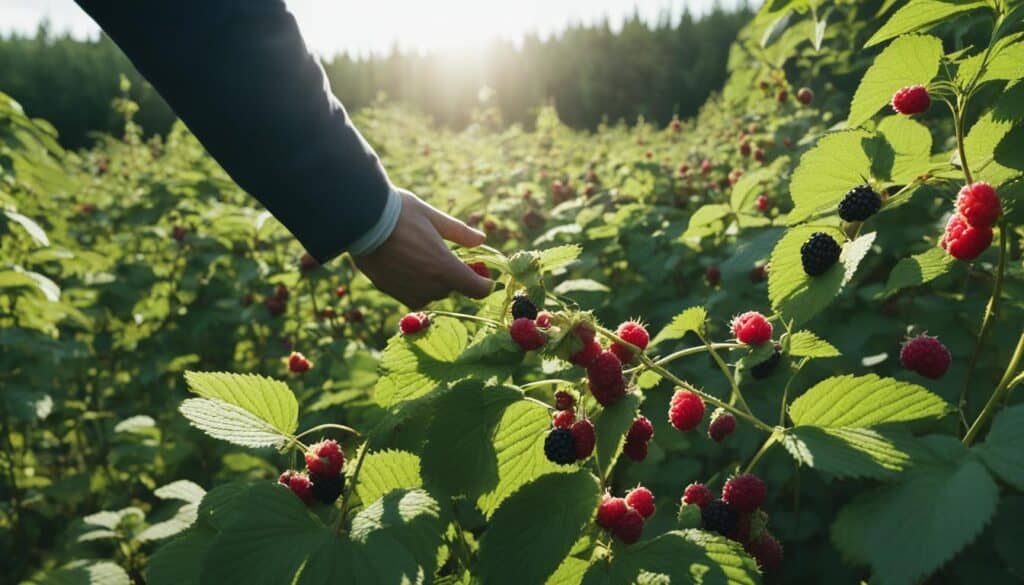
If you’re planning to gather wild raspberries and blackberries, it’s important to understand the different ripening periods for each species. This allows you to make multiple visits to the patches and ensure a plentiful harvest.
Here’s a general timeline for when to gather wild raspberries and blackberries:
- June: Black raspberries
- Mid-July: Wineberries
- Early August: Blackberries
By gathering the berries at their peak ripeness, you’ll be able to enjoy their sweet and juicy flavors. Remember, nature’s bounty is not just for humans to enjoy, so be considerate of other creatures that may also be vying for these delicious treats.
Stay tuned for the next section, where we’ll explore the enticing benefits of foraging for wild raspberries and blackberries.
Why Forage for Wild Raspberries and Blackberries?
Foraging for wild raspberries and blackberries offers a delightful and fulfilling experience. These vibrant and luscious fruits are not only abundant but also accessible during the summer season. With their bright colors and shiny appearance, wild brambleberries are a feast for the eyes and taste buds. But their appeal goes beyond their visual allure – they are packed with essential antioxidants, vitamins, and minerals, making them a healthy snack option. From promoting cardiovascular health to boosting immunity, raspberries and blackberries are known for their numerous health benefits.
I remember my childhood days spent venturing into the woods, eagerly searching for wild raspberries and blackberries. The sweet and juicy taste of these berries made every adventure worthwhile, and I always returned with stained hands and a contented smile.
The act of foraging for wild raspberries and blackberries allows us to connect with nature and appreciate the bounty it provides. As we carefully gather these berries, we become part of the environment, fostering a deeper connection with the world around us. The experience evokes nostalgia, transporting us back to carefree summer days and the simple joys of childhood.
Whether you’re exploring a nearby forest or venturing into the countryside, foraging for wild raspberries and blackberries immerses you in nature’s treasure trove. It encourages us to slow down, observe, and appreciate the wonders of the natural world. The meditative rhythm of picking berries, listening to the whispers of the breeze, and relishing the fragrance of the surrounding flora creates a sense of peace and serenity.
So why not embrace the enchanting world of wild raspberries and blackberries? Head out into nature, breathe in the fresh air, and savor the joy of gathering these delectable brambleberries. Delight in their flavors, appreciate their health benefits, and create lasting memories amidst the beauty of the outdoors.
| Benefits of Foraging Wild Raspberries and Blackberries |
|---|
| Abundant and accessible summer fruits |
| Rich in antioxidants, vitamins, and minerals |
| Offers a fulfilling and joyful connection with nature |
| Evoke childhood memories and symbolize the joys of summer |
Foraging for wild raspberries and blackberries is a rewarding journey that nourishes both body and soul. So, grab your basket and immerse yourself in the delight of these precious brambleberries.

How to Harvest and Prepare Wild Raspberries and Blackberries
Harvesting wild raspberries and blackberries requires some patience and careful handling. The ripe berries need to be individually plucked by hand, which can be time-consuming, but the reward is worth it. When gathering, it’s essential to be mindful of the prickly thorns and potential encounters with mosquitoes. Some species produce clusters of berries that ripen all at once, while others have a more staggered ripening period. To make the most of the harvest season, it’s recommended to visit the patches multiple times across several weeks. Since berries perish quickly, it’s advisable to freeze them if not consumed immediately.
“The ripe berries need to be individually plucked by hand, which can be time-consuming, but the reward is worth it.”
Wild raspberries and blackberries can be used in a variety of culinary applications, such as making jams, jellies, pies, smoothies, muffins, cakes, fruit leather, and even wine. Young shoots and leaves of certain Rubus species are also edible and have their own unique flavors and uses.
Harvesting Tips
Here are some tips for successfully harvesting wild raspberries and blackberries:
- Wear protective gloves and clothing to avoid scratches from thorns.
- Pick only ripe berries that easily detach from the plant with a gentle tug.
- Avoid gathering berries that are mushy or have signs of mold.
- Carry a container or basket to collect the berries, being mindful not to crush them.
- Visit the patches during the cooler parts of the day to avoid mosquitoes and birds.
Raspberry Recipes
If you’re wondering how to make the most of your wild raspberry and blackberry harvest, here are a few delicious recipes to try:
| Recipe | Description |
|---|---|
| Raspberry Jam | A classic recipe that preserves the sweet and tangy flavor of raspberries. |
| Blackberry Pie | A delightful dessert that highlights the rich and juicy taste of blackberries. |
| Raspberry Smoothie | A refreshing and nutritious blend of raspberries, yogurt, and your favorite fruits and vegetables. |
| Raspberry Muffins | A perfect breakfast treat or afternoon snack bursting with the flavor of fresh raspberries. |
| Blackberry Cake | A moist and decadent cake with layers of blackberry jam and cream cheese frosting. |
These recipes are just a starting point, and you can get creative with your own culinary creations using wild raspberries, blackberries, and brambleberries.
Now that you know how to harvest and prepare wild raspberries and blackberries, it’s time to venture into nature’s bounty and enjoy the delicious rewards of your foraging efforts.
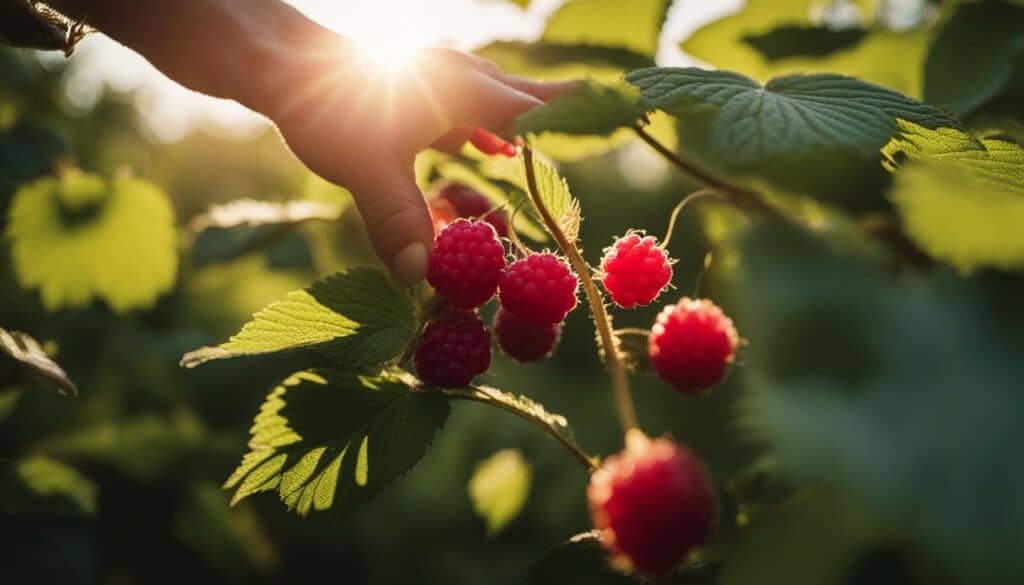
How to Sustainably Work with Wild Raspberries and Blackberries
Working with wild raspberries and blackberries can be done sustainably, as these fruits have evolved to tolerate and even benefit from human interaction. In fact, trampling on the canes while harvesting can stimulate new root growth and help propagate the plants. Humans have likely been intentionally propagating brambleberries for thousands of years. While these fruits have only been domesticated more recently, they are naturally abundant and resilient in the wild.
Foragers can engage in sustainable practices by treading lightly in the patches, allowing new canes to establish themselves, and participating in responsible harvesting techniques. Additionally, home gardeners and farmers can cultivate cultivated raspberry varieties, which also provide environmental benefits and contribute to sustainable berry production.
Responsible Harvesting Techniques
When harvesting wild raspberries and blackberries, it’s important to follow these sustainable practices:
- Harvest only what you need and leave the rest for wildlife and other foragers.
- Tread lightly to minimize damage to the plants and their surrounding habitat.
- Pick berries gently to avoid damaging the canes and future fruit production.
- Avoid using pesticides or herbicides that can harm the plants and the ecosystem.
- Respect private property rights and obtain permission before harvesting in someone’s land.
By practicing responsible harvesting techniques, you can ensure the continued abundance of wild raspberries and blackberries for future generations to enjoy.
Raspberry Farming: Cultivated Raspberry Varieties
Aside from working with wild raspberries and blackberries, cultivating raspberry varieties is another sustainable option. Raspberry farming allows you to grow these delicious fruits in a controlled environment, providing consistent harvests and reducing the dependence on foraging.
Cultivated raspberry varieties offer a range of flavors, colors, and characteristics to suit different tastes and preferences. Some popular varieties include:
- Heritage: A classic red raspberry variety known for its excellent flavor and productivity.
- Tulameen: A large and juicy raspberry with a sweet and tangy flavor.
- Golden Bliss: A yellow raspberry with a sweet and slightly acidic taste.
- Autumn Bliss: An everbearing variety that produces fruit in late summer and fall.
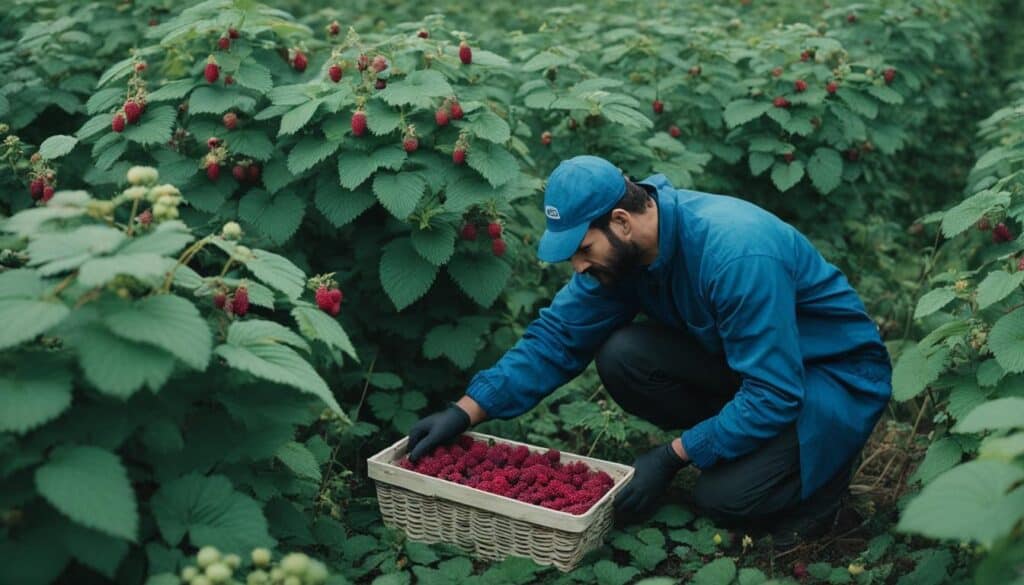
Raspberry farming allows you to have a consistent supply of fresh raspberries throughout the growing season. By providing the right care, such as proper pruning, fertilization, and pest management, you can create a sustainable and productive raspberry farm.
Whether you choose to work with wild raspberries and blackberries or cultivate raspberry varieties, incorporating these sustainable practices into your berry activities ensures the preservation and enjoyment of these delicious fruits for years to come.
What Are Tree Fruit Like Raspberry Varieties?
When it comes to tree fruit like raspberry varieties, there are several options to explore beyond the traditional raspberry. These varieties offer unique flavors and characteristics, adding diversity to your fruit garden. Let’s take a closer look at some of the tree fruit like raspberry varieties:
| Tree Fruit | Description |
|---|---|
| Mulberry | Mulberry trees are known for their mid-sized stature and elongated raspberry-like berries. They can be easily grown from cuttings or seeds and are cold hardy. |
| Hackberry | Hackberry trees, found in various regions of the northern hemisphere, produce dry-textured berries with a sweet taste. |
| Buffaloberry | Buffaloberry is native to North America and has both bitter and sweet notes. It is traditionally mixed with sweeter fruits to reduce bitterness. |
| Soapberry | Soapberry trees, found in the southern and southeastern USA, have berries that are not edible but can be used to make soap due to their high saponin content. |
| Rowan | Rowan, also known as Mountain Ash, produces bright berries that can be made into jelly or dried and used as a coffee substitute. |
| Yew | Yew trees have soft, fleshy red berries with sweet flesh, but they are toxic to consume and must be handled with caution. |
These tree fruit like raspberry varieties offer a range of flavors and culinary possibilities. Whether you’re looking to add something new to your fruit collection or want to explore unique flavors, these varieties are worth considering. Just remember to handle them with care and research any specific requirements they may have for optimal growth.
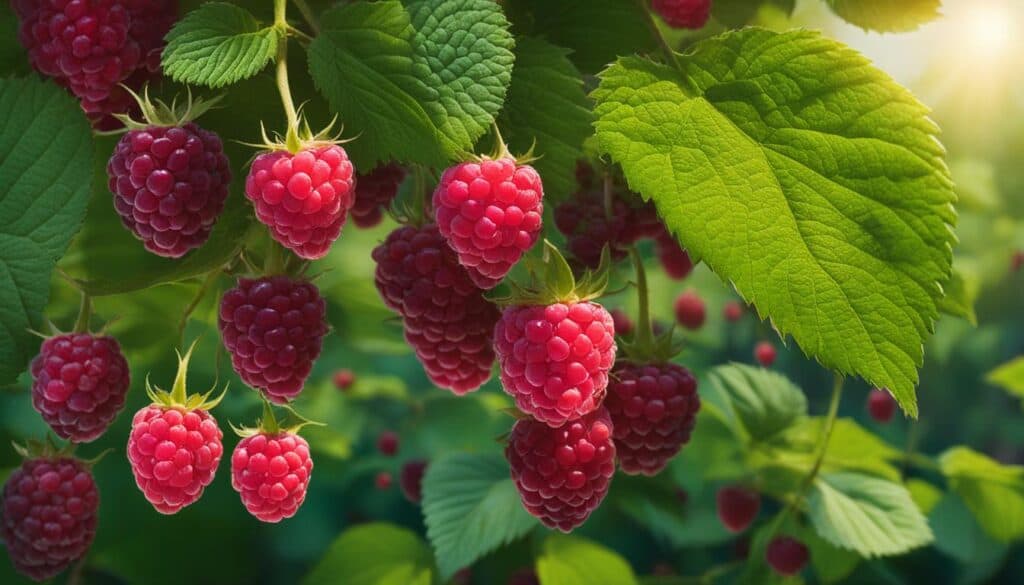
Best Raspberry Varieties for Growing at Home
When it comes to growing raspberries at home, there are several excellent varieties to consider. Whether you prefer summer bearing raspberries or everbearing raspberries, there is a raspberry variety that will suit your needs.
Summer Bearing Raspberry Varieties
For those who enjoy a bountiful harvest during the summer months, the following raspberry varieties are highly recommended:
- Boyne: Known for its excellent flavor and cold hardiness, Boyne is a reliable choice for gardeners in cooler climates.
- Cascade Delight: This variety is disease resistant, making it a great option for gardeners looking for low-maintenance raspberries.
- Killarney: If you live in an area with extremely cold temperatures, Killarney is the perfect raspberry variety for you. It is highly cold tolerant and can withstand harsh winters.
- Raspberry Shortcake: Raspberry Shortcake is a compact, thornless raspberry variety that is perfect for small spaces such as containers or gardens with limited area.
- Royalty: Royalty is known for its large purple fruit, making it an attractive choice for both visual appeal and taste.
Everbearing Raspberry Varieties
If you prefer a longer harvest season and a continuous supply of raspberries, consider these everbearing raspberry varieties:
- Anne: Anne raspberries have a tropical flavor, making them a unique and delicious addition to your garden.
- Dorman Red: This variety is heat tolerant, making it an excellent choice for gardeners in warmer climates.
- Fall Gold: Fall Gold raspberries are cold tolerant, allowing you to enjoy raspberries well into the fall season.
- Heritage: Heritage is a disease resistant variety that produces a bountiful harvest of flavorful raspberries.
- Jewel: Jewel raspberries produce sweet black raspberries, adding variety to your raspberry collection.
- Joan J: This variety boasts large and delicious fruit, perfect for eating fresh or using in your favorite raspberry recipes.
- Polka: Polka raspberries are highly productive and have a sweet taste, making them a popular choice for home gardeners.
- September: As the name suggests, September raspberries ripen late in the season, extending your raspberry harvest well into autumn.
Each of these raspberry varieties has its own unique features and characteristics, allowing you to find the perfect fit for your growing conditions and personal preferences. So, why not bring the joy of freshly picked raspberries into your own backyard?
Conclusion
Tree fruit like raspberry varieties offer a world of delicious possibilities for growers and fruit enthusiasts alike. From the wild brambleberries of North America to cultivated raspberry varieties, these fruits provide a diverse range of flavors, colors, and harvesting seasons. Foragers can enjoy the satisfaction of gathering these succulent berries from natural habitats, while home gardeners can cultivate their own raspberry plants to enjoy fresh fruit from their yard.
Whether you prefer the classic red raspberries or want to explore unique varieties like black raspberries or yellow raspberries, there is a raspberry variety for everyone. With proper care and attention, raspberry plants can provide bountiful harvests for many years, allowing you to savor the delights of tree fruit like raspberry. So, dive into the world of raspberry varieties and discover the joy of growing and enjoying these heavenly fruits.
FAQ
What are tree fruit like raspberry varieties?
Tree fruit like raspberry varieties include mulberry, hackberry, buffaloberry, soapberry, rowan, and yew. Each tree fruit has its own unique characteristics and uses.
What are wild brambleberries?
Wild brambleberries are a group of fruits that include blackberries, raspberries, and related species from the Rubus genus. These fruits grow in thorny thickets along woodland edges and come in various colors and flavors.
Where can I find wild raspberries and blackberries?
Wild raspberries and blackberries can be found in different regions of North America, primarily along woodland edges. The distribution of Rubus species reveals different groups of species in different regions, including the eastern half of North America, the west coast, and the northern and mountainous group.
When is the best time to gather wild raspberries and blackberries?
The timing for gathering wild raspberries and blackberries depends on the climate and the species. Generally, new canes start emerging in March and April, and the harvest season usually begins in June for the hottest climates and continues until late August for cooler climates.
Why should I forage for wild raspberries and blackberries?
Foraging for wild raspberries and blackberries offers several benefits. These fruits are abundant and accessible, and they are known for their bright colors, sweet taste, and nutritious qualities. Foraging also provides an opportunity to connect with nature and enjoy the joys of summer.
How do I harvest and prepare wild raspberries and blackberries?
When harvesting wild raspberries and blackberries, it’s important to be mindful of thorny stems and competing with animals. The ripe berries should be individually plucked by hand, and they can be used in various culinary applications such as jams, pies, smoothies, and more.
How can I work sustainably with wild raspberries and blackberries?
Working sustainably with wild raspberries and blackberries involves treading lightly in the patches, allowing new canes to establish, and engaging in responsible harvesting techniques. Home gardeners and farmers can also cultivate cultivated raspberry varieties to contribute to sustainable berry production.
What are other tree fruit like raspberry varieties?
Tree fruit like raspberry varieties include mulberry, hackberry, buffaloberry, soapberry, rowan, and yew. Each variety has its own unique flavors and uses, such as making jam, jelly, or even soap.
What are the best raspberry varieties for growing at home?
For summer bearing raspberries, popular choices include Boyne, Cascade Delight, Killarney, Raspberry Shortcake, and Royalty. For everbearing raspberries, recommended varieties include Anne, Dorman Red, Fall Gold, Heritage, Jewel, Joan J, Polka, and September. Each variety has its own unique features and is suitable for different growing conditions.
How do I conclude my journey into the world of tree fruit like raspberry varieties?
Exploring tree fruit like raspberry varieties offers a world of delicious possibilities. From wild brambleberries to cultivated raspberry varieties, there is a raspberry variety for everyone. With proper care and attention, raspberry plants can provide bountiful harvests for many years, allowing you to savor the delights of these heavenly fruits.

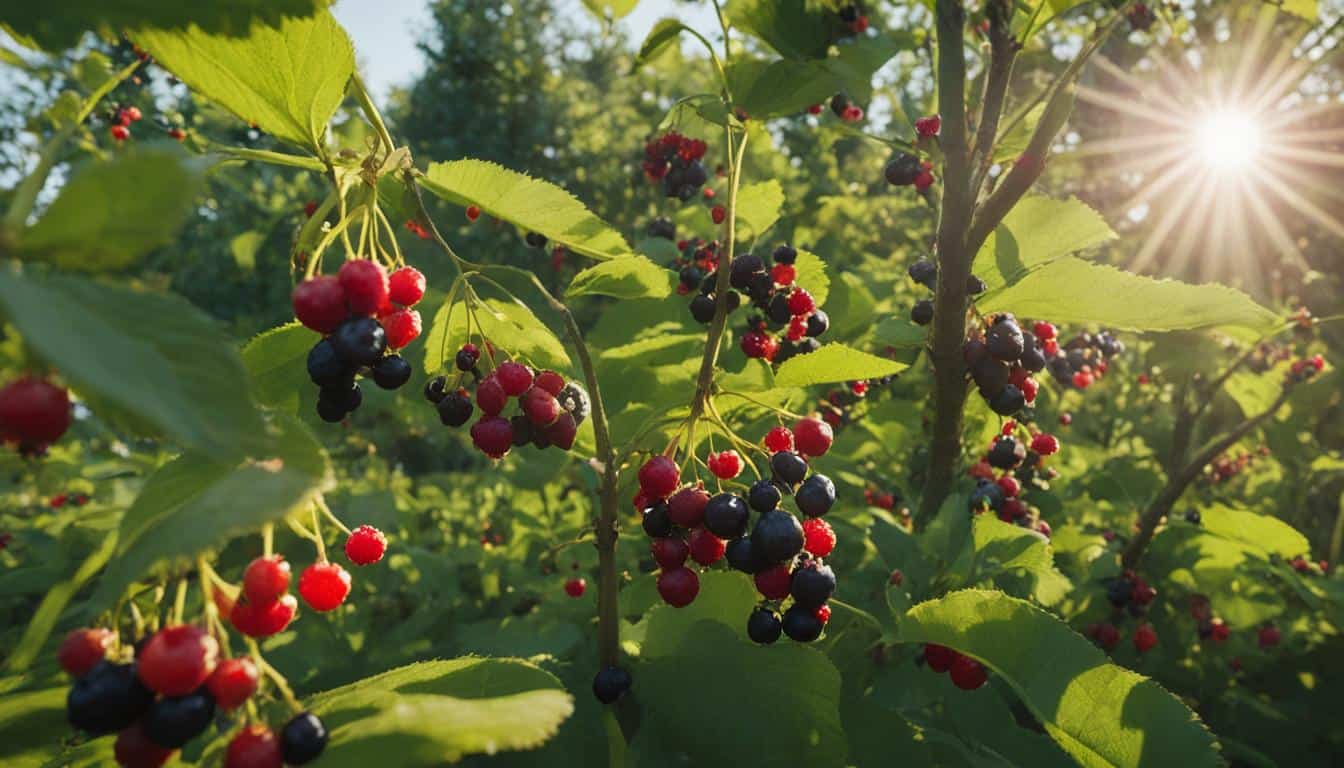



Leave a Reply